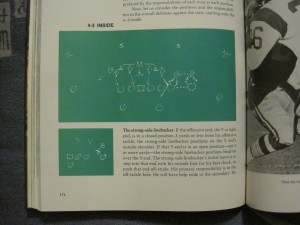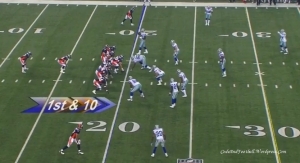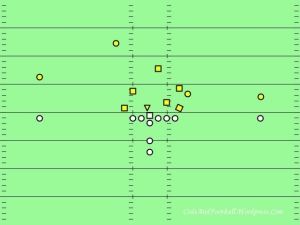The Dallas Morning News has a cute article, about how the first defensive call by Rob Ryan on the first defensive play of the first preseason game of Dallas in 2011 was the 43 Flex. I recall watching that play and thinking “psycho front”. And yes, Ryan has 4 players along the line of scrimmage and 3 players at linebacker depth, but what we’re going to do in this article is talk about about Tom Landry’s first two defenses, the 43 inside and 43 outside, and how they then morphed into the flex, to better use the talents of their All-Pro defensive tackle, Bob Lilly.
If you have the set “Vince Lombardi on Football“, then you have perhaps the best resource I can locate on the 4-3 inside and the 4-3 outside. Pages 174 through 185 cover these two defenses. The physical setup of the defensive line is the same in both cases. In the 4-3 inside, the defensive tackles rush into the “A” gaps and the middle linebacker is responsible for both “B” gaps. In the 4-3 outside, the defensive tackles rush into the “B” gaps and the middle linebacker is responsible for both “A” gaps. The front, from the offenses left to right, is a “5-2-2-5” alignment, with the tackles head up on the offensive guards, and the ends on the outside shoulders of the tackles. The middle linebacker is 1.5 yards deep, the strong side linebacker is nose onto the tight end if the tight end is separated, suggesting strong side sweep.
The ideas for the Flex came about after Bob Lilly’s move from left defensive end to right tackle. Dick Nolan describes it as one half of the line playing a 43 inside, one half playing a 43 outside. To note, the tackles in the inside/outside are flexed. In Tom Landry’s Flex, however, it depended on which side of the offense was “strong”, or likely to be the side players would run to. Bob, in Peter Golenbock’s book, describes it as follows:
If I were on the weak side, I’d be head-up with the guard, right on the line of scrimmage, whereas the tackle on the other side would be three feet back. George Andrie would be right over the tackle and instead of being on his outside shoulder, he’d be head-up, three feet back. He would be keying my guard. I also keyed my guard.
As Dick Nolan explains
Let’s say the other team tries the old Lombardi sweep. When that guard pulls and that center tries to choke back to get Lilly, he can’t get to him quick enough because Lilly can just go around him, and the center will fall down on his nose trying to block him. Lilly will be running right behind their guard, and Paul Hornung will be running the ball, and Paul Horning can’t come back, because if he does, he’ll be running right back into Lilly…
To guard against the counter, the off side defensive end now plays a 4 technique as opposed to a 5. That end is responsible for the weak side gap that the off side defensive tackle has left behind.
When introduced, it caused a lot of confusion, because Dallas soon came to be able to play the 43 inside/outside from the Flex set. That was the upside, as no one knew what they were actually playing. The downside is the weak side defensive end’s pass rush was effectively stuffed whenever the Flex was played. By the late 1970s early 1980s, it became almost automatic for teams to pass when they saw the Flex. Consequently, as Charlie Waters explains in Golenbock’s book, the Flex was played less and less.
In the 1990s, Dallas switched to the Miami 43, versions of which are still played today. A derivative of the Miami 43 is Ron Vanderlinden’s Stack defense, discussed briefly here.
And now we have Rob Ryan’s 43 Flex. No, it doesn’t look a bit like the Tom Landry defense, but does resemble, somewhat, the double eagle flex defenses that were popularized by Dick Tomey and Rich Ellerson. A screen shot and a diagram of Rob’s defense follows.
Notes: updated due to typos, and a very nice article on Blogging the Boys that identified each player along this front. Further, the blog Compete in All Things has some Xs and Os on the modern 43 Flex.








May 25, 2012 at 10:46 am
[…] we pointed out here, the 4-3 Flex is derived from the Inside and the Outside, and thus is also a one gap defense. The […]
June 8, 2013 at 4:04 pm
[…] York Giants, has a 4-3 that isn’t anyone’s adjustment to something else. It’s a full blown base defense, a creation of his own hard work and imagination. It’s a largely 1 gap, keying defense, with […]
June 12, 2013 at 9:35 am
[…] I’ll note that Paul Brown is assuming that the “flex” concept is identical to gap control, a common element in all the major Landry defenses. We discuss the differences between Tom’s New York defenses, the 4-3 inside/outside, and his later 4-3 flex, here. […]
June 21, 2013 at 12:29 pm
[…] base defense in 1956. Sam Huff’s bio, “Tough Stuff”, makes it clear that both the 4-3 Inside and 4-3 Outside were in place by 1956 (2). Jim Brown entered the league in 1957. Let’s just not go there, […]
August 15, 2013 at 11:16 am
[…] he talks about the Tom Landry flex defense, and rather than focusing on the tackle up on the line, he discusses a flex strong and the pursuit […]
December 13, 2013 at 2:22 pm
[…] It was then that Tom Landry orchestrated what was probably the most complex defense in NFL history. The 4-3 Flex. The Flex defense required the utmost discipline and it took a very long time for most players to […]
December 19, 2014 at 11:15 pm
I still feel like I don’t understand exactly what techniques the DT’s were playing in the 4-3 outside. In the 4-3 inside, the inside DT’s slanted from 2-techniques into the A gaps while the outside DT’s filled the B gaps. So was the 4-3 outside a B gap/C gap assignment with the Mike backer plugging both A gaps? What am I missing? I didn’t make the connection from gap assignments to flexed alignment off the ball. Very interesting read though. I’m intrigued and would like to know more. I’m going to poke around on the site for ideas. I’m working on building my own site about football schemes.
December 20, 2014 at 11:25 am
* So was the 4-3 outside a B gap/C gap assignment with the Mike backer plugging both A gaps?
Yes. One gap for linemen, two for the linebacker. In the 1950s, it was a work in progress. Read one of Sam Huff’s bios. Understand that in the 1950s, there was very little size
difference between a linebacker and a lineman. Sam was a guard in college. The OTs on Greasy Neal’s championship Eagles teams weighed about 220 pounds.
* I didn’t make the connection from gap assignments to flexed alignment off the ball.
gap assignments aren’t correlated with flexed linemen. You flex linemen for the same reason you pull linebackers off the line. You give them more time to read keys and pursue laterally.
The inside/outside were not the first defenses to routinely flex a lineman. Bud Wilkinson’s 5-2 Oklahoma, in its first incarnations, flexed the nose guard, to give him time to read the center.
and control the A gaps.
Getting a copy of Bill Arnsparger’s book, Coaching Defensive Football, and checking out his discussion of the weak side DE in Tom Landry’s 4-3flex will help in this regard.
April 5, 2018 at 5:31 am
[…] The 43 Flex, from Tom Landry to Rob Ryan from Code and Football […]
April 5, 2018 at 5:02 pm
[…] So what were these revolutionary new assignments? Turns out we know because Vince Lombardi took the 43 inside and outside to Green Bay and those defenses he used for the rest of his coaching career. Later, a book called “Vince Lombardi on Football” was written and in that book, every assignment of every player was documented. We’ll borrow some images from my article on the 43 Flex. […]